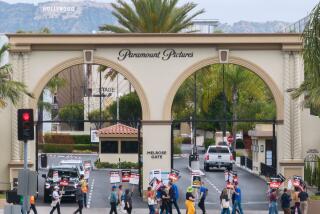Filmmaker with a badge is inspired by the streets he patrols
The movie crew scurried to set up camera dollies and lights in the lobby of the faded Baltimore Hotel in downtown Los Angeles.
The scene to be filmed at the 113-year-old lodging house at the corner of 5th and Los Angeles streets would depict a good Samaritan leading a drugged-up woman from skid row to get her off the street during a chilly winter’s night.
The good guy was being played by David Marroquin. The heroin-addicted young woman was portrayed by Mary Morales.
Marroquin is a 30-year-old officer with the Los Angeles Police Department whose beat for the past 4 1/2 years has been an eight-square-block area of skid row. When off duty, he is one of L.A.’s legions of aspiring filmmakers, writers and actors — but with a twist: his police beat is his inspiration.
“The things you see and stories you hear out there are just heart-wrenching,” he said. “There are parts of humanity that are dark and troubling.”
About 10 months ago, Marroquin was on patrol at 7th and San Pedro streets when he encountered a newcomer to the area. Her name was Ashley, he learned, and “she was young and pretty — she really stood out.”
But his heart sank when it became apparent she was a heroin user.
Six months after that, Marroquin spotted the woman at the department’s jail division when two officers had arrested her for being under the influence. Even though she could barely stand up, Ashley remembered their earlier encounter. “At 7th and San Pedro,” she slurred.
A few days later he saw her again on the street. It was raining, and she told him she didn’t know where she would be spending the night. “I drove home that night with a huge weight bearing down on my shoulders,” Marroquin said.
That’s when he decided that he wanted to produce a feature-length film that shows how homeless, addicted and suicidal individuals can disappear into “the blind spots of our communities.” Morales, a friend who is also an actor and musician, quickly agreed to help write a script for “Between the Fall and Rise” and play his Ashley character.
It was dark outside the Baltimore Hotel as Morales, a 33-year-old Studio City resident who works part-time at an Apple store, sat on a cold marble lobby bench. Operators of the hotel and the nearby Nickel Diner are among several locations that offered to let the film crew use their sites for free.
Makeup artist Nora Stahl knelt on the lobby’s train-station-tile floor as she applied 30 realistic-looking “needle” marks on Morales’ arm and neck. Foundation greasepaint made her cheeks and eyes appear sunken and her fingernails look unkempt and dirty.
“I lost 12 pounds to look gaunt for this,” Morales said. “That’s the least-important part: I’ve also temporarily taken up smoking.”
As she prepared for the role, she researched the characteristics of heroin addicts and asked to speak with the real Ashley. Marroquin hunted the woman down once more, explained his plans for a fictional movie and asked her if she would speak with Morales. “She said she would love to. We set it up to meet the next Saturday,” he said.
But Ashley was a no-show when Marroquin and Morales arrived at the prearranged skid row meeting place.
“Hopefully, she found a ticket to go home,” he said. “These streets will eat you up.”
In the meantime, Marroquin and Morales began talking up their plans and spreading the word that they were looking for other actors and production crew members who were willing to work on the movie for next to nothing. Soon, they had recruited 18 professional filmmakers — camera operators, lighting and sound technicians and makeup artists — for the project.
The film’s director of photography, David Frederick, has been a Hollywood camera operator since 1987. His credits include the films “The Soloist” and “Muppets From Space,” and the TV series “Northern Exposure.”
“I met David through Mary,” he said. “She told me, ‘You wouldn’t want to do it because there’s no pay.’ But then I heard what the film is about.”
Frederick arranged to borrow about $250,000 worth of newly released Canon EOS C 300 professional cinema cameras and lenses. It helped, he joked, that he produced this month’s 2013 Lifetime Achievement Awards show for the Society of Camera Operators.
Doug Burch, co-founder of the independent film production company Little Dog Productions, met Marroquin in December at a Christmas party and was intrigued by the movie’s story line.
“This is a passion project for all of us,” said Burch, who is executive producer of “Between the Fall and Rise.” “The more he talked about it, the more excited I got.”
Cristian Coldea, the film’s second assistant camera operator, is from Romania. He was stunned by what he saw when the crew spent one evening shooting near the corner of 5th and Wall streets.
“It’s a different world,” Coldea said as he helped line up a dolly shot outside the Baltimore. “People came up in a threatening way, and one person asked why we didn’t have security with us. David had to show his badge and gun a few times.”
Marroquin is financing the film through donations from family members and friends and from those responding to a campaign on the crowd-funding website Indiegogo. He anticipates its final cost to be $62,000 when equipment rental and insurance costs, Screen Actors Guild clearance fees and modest payments for actors are tallied.
Among those in line to be paid are several skid row inhabitants who have significant lines in the movie. “They were very excited,” Marroquin said. “It was kind of magical for them to be in a film.”
More to Read
Sign up for Essential California
The most important California stories and recommendations in your inbox every morning.
You may occasionally receive promotional content from the Los Angeles Times.











